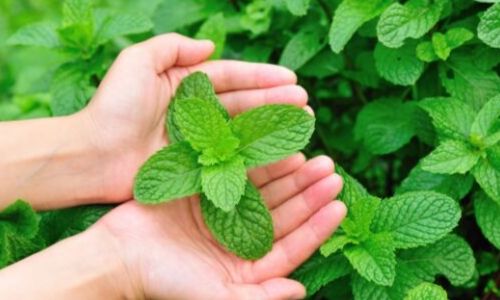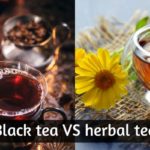Mint tea is one of the best herbal teas out there. You've probably had at least one cup in your entire life, and were pretty impressed by now literally cool it was.
For me mint tea is something that will always remind me of grandma, and going into the woods to pick berries or mushrooms. We'd always come back with something, and sometimes it would be freshly picked mint.
So this guide's meant to teach you everything about mint tea, starting with the basics.
Table of Contents
What is mint tea ?
Mint tea is an infusion made from the dried leaves (and sometimes stems) of the mint plant. There are several mint plants as this is a large family of plants, but the most commonly used are spearmint and peppermint.
Tea can be made from both variations, and I'll get into that in a bit.
Mint tea, being a herbal tea, does not contain caffeine and has several health benefits that make it a staple in anyone's home. It's been in use for many centuries, and is known pretty much anywhere on the planet.
Is mint a herb ?
Yes, mint is a herb. It belongs to the Mentha family, which includes nearly 24 species of mint. Not all of them are used for tea, or are available for regular use, but the most common ones like spearmint and peppermint are.
As it is a herb, it is commonly used both in cooking and preparing drinks (Mojito comes to mint, as does Hugo), usually in its fresh, raw form. For tea though, you need the completely dried leaves of the mint plant, in order to get the right flavor.
Mint is a perennial herb, meaning it will live for several years before you need to plant it again. So if you have your own little mint plant at home, you can pick it time and time again and make your own tea from it.
Peppermint vs spearmint
As there are several mint types, not all of them are used regularly. But there are 2 variations that have stood out over the centuries.
Both are real mint, and they have fairly different flavors. While both are minty and contain menthol, they're a bit different from one another.
Peppermint is the spicier one (hence the name containing 'pepper'), and is most often used in foods, especially around the holidays. Think peppermint back, candy canes and peppermint hot cocoa.
It's the most potent mint type, and in truth that's because it's actually a hybrid between spearmint and water mint. The hybridization happened naturally, ages ago, and made peppermint the strongest mint out there.
It's got a higher menthol content - about 40% - and that's what makes it so in-your-face minty. It also makes it the best candidate for tea, since you won't need as much as spearmint.
As for spearmint, this is the 'original' mint, in that it's the most common variety and seems to be at the base of most hybrids or variations. It's got a lower menthol concentration, almost tiny in comparison with peppermint. But, it's also noticeably sweeter.
Spearmint is the milder, sweeter version of mint, and it's usually got more minty, herb-like flavor rather than actual mint essential oil. So it's more of a delicate mint. You can make tea out of spearmint as well, you just need to know to expect less than with peppermint.
Where does mint come from ?
Mint is native to many parts of the world, and it has several cultivars, variations and hybrids as a result. You'll find mint indigenous to the U.S., European mint, African mint, Asian mint, and so on.
Most of the time though, 'mint' is meant as spearmint, as it's the most common variety. It's originally from Europe, and Southern Asia, reaching all the way from Ireland to Southern China.
It naturalized in other continents as well, so you will not find it happily growing in the Americas, as well as North and South Africa. In some places it may need to be replanted every year, since it might not survive very harsh winters.
So if you were wondering where your mint comes from, the answer is that it could come from anywhere, since it's a widely grown plant and might be in your backyard as well.
How to make mint tea (mint tea recipe)
Alright, now you know what mint is, where it's from, and the whole peppermint vs spearmint discussion. But how do you actually make mint tea ?
First, we need to clarify that using fresh mint leaves for tea will not get you the same flavor as dried mint leaves.
I know, it sounds insane. Why use dried leaves when you have fresh ? The problem is the very fact that they are fresh.
You see, adding fresh mint leaves to very hot water (about 90 C/194 F) will result in a minty brew, yes, but also an overly herb-like flavor as well. The freshness would make the leaves act as if they were scalded.
So, dried leaves have all moisture from them removed, and only the menthol and flavor left in them. Which is why they're preferable to use in tea, rather than fresh leaves.
You can try with fresh leaves if you like, but be warned that it might not turn out as you like.
Now let's get to exactly how to make this mint tea. You'll need:
- 9 oz of hot water, 90 C/194 F
- 3 heaping teaspoons of dried mint leaves
- a filter, strainer, or tea ball/infuser
- a tea mug
- a pot to boil water
Note that I said to use a pot (or kettle) to boil the water, as opposed to using the microwave to heat the water. This is because boiling raises the temperature evenly, while microwaving tends to be uneven and sometimes full of unwanted surprises.
So being your water to boil, and once it's boiling turn the heat off. Let it stand, off heat, for 2 whole minutes before adding it to the leaves. This way you're sure the water will cool off enough to get to 90 C/194 F.
When adding the tea leaves, you can do this one of two ways. You can either add the tea leaves to the pot, and then strain the tea into the mug when it's done brewing, or add the leaves to an infuser in the mug, and pour water over the infuser.
What I've noticed is that using the second method is more convenient, especially if you only make one cup at a time. Easier to clean, and to handle.
For example this mug by Sweese is the best way to do this. It's a porcelain cup, and it can hold up to 15 oz of liquid, without the filter. It's got one cup/mug, one metal filter/infuser that can be removed, and one porcelain lid that can also act as coaster or trivet.
When judging how much tea you want, keep in mind that you need to allow for the filled filter, so you'll get less that 15 oz of actual brew.
You can check the listing on Amazon here, and read the reviews as well.
As for how long to let the mint steep, allow it 5 minutes and it should be done. It won't turn bitter, but it doesn't need a long time to brew. And remember that some part of the water you're using will remain within the tea leaves, and on the leaves themselves.
This s why I said to use 9 oz of water, so you're left with 8 in the end.
Should you use peppermint or spearmint ?
Whichever herb you use is up to you, and what kind of flavor you're after.
If you want an especially minty, strong flavor then you should go with peppermint. You might even need to use less leaves than I mentioned, if you've got a good batch of mint.
But if you're going for a more subtle, delicate mint flavor then maybe you should go for spearmint, since that's usually sweeter and less ...well, less minty.
A strong peppermint loose leaf tea is this one by Frontier. They usually deal with bulk herbs, most of the time organic. This peppermint is organic, cut and sifted, and comes in a 16 oz bag.
This means you get get several months' worth of peppermint tea by using these bulk herbs, since you only need 203 teaspoons at a time. IF you store them properly, they can last you almost an entire year.
Be prepared for a very strong aroma when you open the bag for the first time.
You can check the listing on Amazon here, and read the reviews as well.
Frontier also has spearmint tea, if you're looking for a tamer, more subtle and definitely sweeter version of mint for your tea. This spearmint comes in a large bag as well (16 oz again), and it, too, will last you several months.
Also cut, sifted, and dried, these organic spearmint leaves will give you a more delicate experience than peppermint, but will still do the job very well.
Be warned that these bags (both this one and the peppermint) are fairly large. The product dimensions stated on their page is 90 x 90 x 30 inches.
You can check the listing on Amazon here, and read the reviews as well.
How to store mint leaves for tea
Storing mint is very much like storing any other tea. You will need to keep it in a dry, dark, airtight container that won't allow any moisture inside.
Or heat, for that matter, since that too can ruin the general flavor of tea. I've made a detailed guide on storing any kind of tea here, and you're welcome to go through it. You might have other teas that need storing, who knows ?
What you need to remember is that mint, and herbal teas in general, don't last very long in storage. As in, less than a year otherwise it loses too much of its flavor.
A good way to store mint leaves for tea is to use tea caddies, since they're great at keeping flavors in, and allowing no air to escape or moisture to seep in.
For example these tins from Leoyoubei are a great way to store tea, since they're large enough to fit loose leaf tea, but small enough to not leaves too much air in the tin.
Total size for each tin is height: 3.55" and diameter: 2.55".
This is a 6 piece set, and each piece is colored very differently from one another, so you have no chance of mixing things up.
And in terms of storage they're pretty nifty, since they've got a double lid system going on. You have an inner lid that seals the tea in, and then an outer lid, to keep everything safe, and completely airtight.
You can check the listing on Amazon here, and read the reviews as well.
Mint health benefits and its effect on health
Mint tea has long been recognized as a way to help alleviate several symptoms of discomfort.
For example it's well known to treat stomach aches, especially if they're digestive problems. The menthol in mint tea (especially peppermint) is a great way to soothe the digestive system, and settle any upset stomach.
It's also useful for loose stools and general bowel discomfort. Along with some fiber heavy foods (like banana and whole grain toast) it should help you feel better within 24 hours.
Mint and menthol can also help with nausea, and vomiting. While they won't 100% cure the problem, they provide you with something to hold up against the queasy feelings, specifically because of how refreshing menthol can be.
And also because of how wonderful mint smells, it's also great for reducing the severity of headaches, and making you feel focused, alert.
It also helps to reduce stress, since a good, pleasant smell is known to help de-stress and relax. The same way lavender and lemon have the same effect on our mints, mint and menthol help as well.
Mint essential oil has been used in aromatherapy for a long time as a focus aid, and mood enhancer along with lemon essential oil. What this means is that mint tea can also be soothing, partly be being warm and warming you from he inside as you drink it, and partly by smelling so nice.
The fact that mint freshens your breath surprises no one, since it's a key ingredient in nearly all toothpastes. You'll find it in varying degrees of strength, but it's there alright.
And for the same reason, because menthol smells so pleasant and manages to reduce bad odors, it has been used as a room deodorizer since ancient times. Either strewn around the room to make it smell better, or used as essential oil on pieces of gauze or fabric in key places in the room.
This great smell also helps with relieving a clogged nose, hence the recommendation to drink mint tea if you have a cold, and add a slice of lemon as well. It also helps with treating the common cold, as it helps with relaxing the muscles and soothes a sore throat.
You know how sore throat lozenges are so minty ? You can get nearly the same effect with a strong cup of tea, providing you with some relief. This is because mint has a mild numbing effect, which contributes to the feeling of coolness you get when drinking mint tea.
Is mint good for you ?
Yes, mint tea is good for you, on an overall level. Especially if you're suffering from mild indigestion or IBS, mint will help you out pretty well, whether you get peppermint of spearmint.
And if you're going through a very stressful period, the smell of mint tea will help you relax, and the menthol itself will help relax your muscles. In this respect it's a very good bedtime tea as well.
So yes, feel free to have a cup of mint tea each day, and if you're a bit unsure it's probably better to ask your doctor.
Is mint safe ?
Yes, mint tea is generally safe to consume. Unless you overdo it, and drink more than 5 cups of mint tea per day, for several days, which I doubt anyone can do for long.
So if you're wondering if you can give mint tea to a child or an elderly person, they should be fine.
The only people who should worry about mint tea are those with acid reflux, since mint can relax the muscles of the esophagus and actually worsen the symptoms of acid reflux.
Mint tea and pregnancy
Generally one or two cups of mint tea would be safe for expectant mothers. This is because the menthol naturally found in mint leaves helps reduce indigestion and IBS symptoms, which are common among pregnant women.
However, this means that the muscles will relax, and in some cases this can lead to miscarriages. By some cases I mean drinking too much mint tea within 24 hours, or being highly sensitive to menthol.
If you've had miscarriages before, then it's probably best to steer from mint tea altogether. Best to not risk it. The same is true for raspberry leaf tea as well.
As for breastfeeding, it would be wise to abstain from drinking mint tea. This is because menthol (even transmitted from the mother to the child) can cause breathing problems in newborns, so again it's best not to risk it.
Does mint tea have caffeine ?
No, mint tea does not contain caffeine. In this respect it's a safe alternative to coffee if you're looking for a warm drink to give you a little pick me up in the afternoon.
If you're looking to wean yourself off coffee and caffeine altogether, drinking mint tea in the morning with your breakfast will be a decent substitute. It's flavorful enough to please your taste buds, but also non-caffeinated, so you're going to get a good placebo.
Conclusion
Mint tea is one of the most common teas out there, and as a herbal tea it's very famous both for flavor and for its health benefits. So, you're bound to fall in love with it once you start drinking more mint tea.
Do keep it as a low intake if you're suffering from stomach ulcers or acid reflux, and maybe steer clear from it altogether if you're pregnant.
For me mint tea is a childhood friend, and I find it in my cup every now and then. I've since grown more fond of true teas, like green and black tea, but a good herbal is always welcome.
If you want to know more about coffee or tea, feel free to check the related articles below. Who knows what else you might find ?











